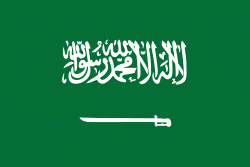Flag of Saudi Arabia
The flag of the Kingdom of Saudi Arabia (علم المملكة العربية السعودية) is the flag used by the government of Saudi Arabia since 15 March 1973. It is a green flag featuring in white an Arabic inscription and a sword. The inscription is the Islamic creed, or shahada: "There is no deity but God; Muhammad is the Messenger of God".
The Arabic inscription on the flag, written in the calligraphic Thuluth script, is the shahada or Islamic declaration of faith:
The green of the flag represents Islam and the sword stands for the strictness in applying justice.
* لَا إِلٰهَ إِلَّا الله مُحَمَّدٌ رَسُولُ الله
* lā ʾilāha ʾillā-llāh, muhammadun rasūlu-llāh
* "There is no deity but God; Muhammad is the Messenger of God."
The flag is manufactured with identical obverse and reverse sides, to ensure the shahada reads correctly, from right to left, from either side. The sword also points to the left on both sides, in the direction of the script. The flag is sinister hoisted, meaning that when viewed from the obverse (front) side, it is hoisted to the left of the flagpole.
The usual color of the flag's green was approximated by Album des pavillons as Pantone 330 C, while the color used on flags at United Nations is approximately Pantone 349. At the 2012 London Olympics, Pantone 355 was used.
The Arabic inscription on the flag, written in the calligraphic Thuluth script, is the shahada or Islamic declaration of faith:
The green of the flag represents Islam and the sword stands for the strictness in applying justice.
* لَا إِلٰهَ إِلَّا الله مُحَمَّدٌ رَسُولُ الله
* lā ʾilāha ʾillā-llāh, muhammadun rasūlu-llāh
* "There is no deity but God; Muhammad is the Messenger of God."
The flag is manufactured with identical obverse and reverse sides, to ensure the shahada reads correctly, from right to left, from either side. The sword also points to the left on both sides, in the direction of the script. The flag is sinister hoisted, meaning that when viewed from the obverse (front) side, it is hoisted to the left of the flagpole.
The usual color of the flag's green was approximated by Album des pavillons as Pantone 330 C, while the color used on flags at United Nations is approximately Pantone 349. At the 2012 London Olympics, Pantone 355 was used.
National flag
Country - Saudi_Arabia
Warning: getimagesize(/Image/Map/MP102358.gif): failed to open stream: No such file or directory in /home/mapnlee7/public_html/MAPNALL/article.php on line 532
 |
 |
Pre-Islamic Arabia, the territory that constitutes modern-day Saudi Arabia, was the site of several ancient cultures and civilizations; the prehistory of Saudi Arabia shows some of the earliest traces of human activity in the world. The world's second-largest religion, Islam, emerged in what is now Saudi Arabia. In the early 7th century, the Islamic prophet Muhammad united the population of Arabian Peninsula and created a single Islamic religious polity. Following his death in 632, his followers rapidly expanded the territory under Muslim rule beyond Arabia, conquering huge and unprecedented swathes of territory (from the Iberian Peninsula in the west to parts of Central and South Asia in the east) in a matter of decades. Arab dynasties originating from modern-day Saudi Arabia founded the Rashidun (632–661), Umayyad (661–750), Abbasid (750–1517), and Fatimid (909–1171) caliphates, as well as numerous other dynasties in Asia, Africa, and Europe.
